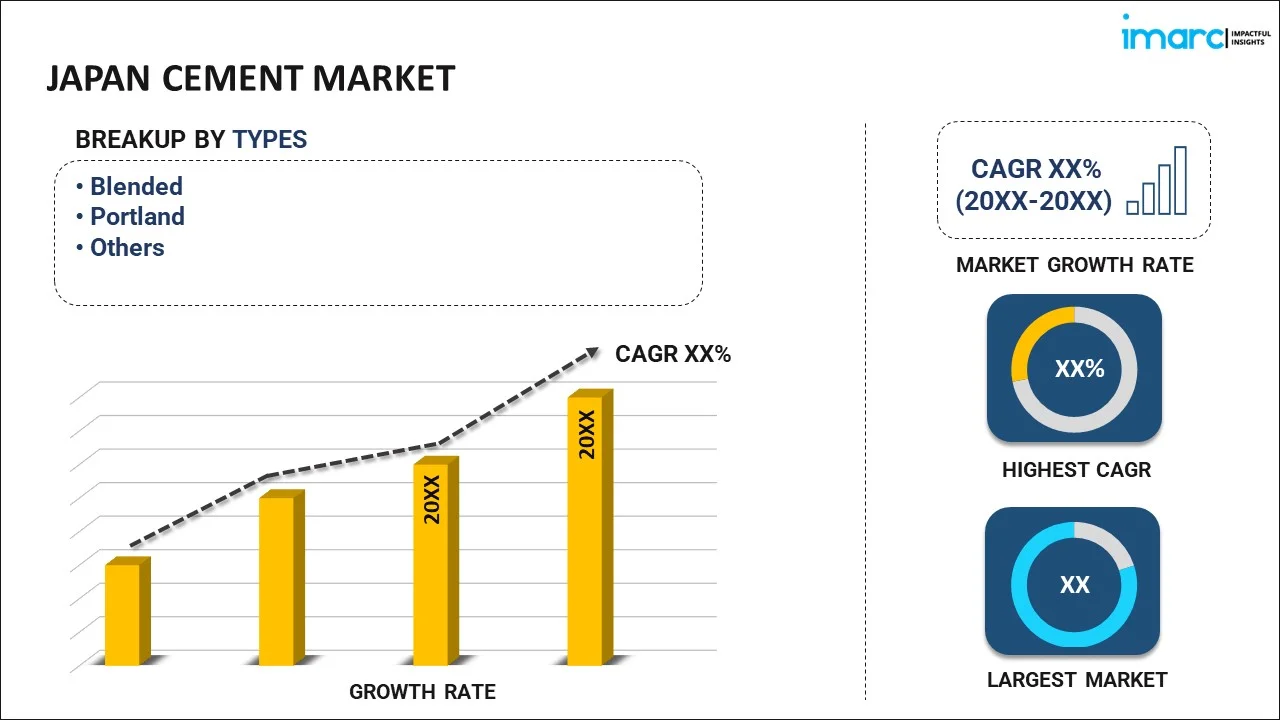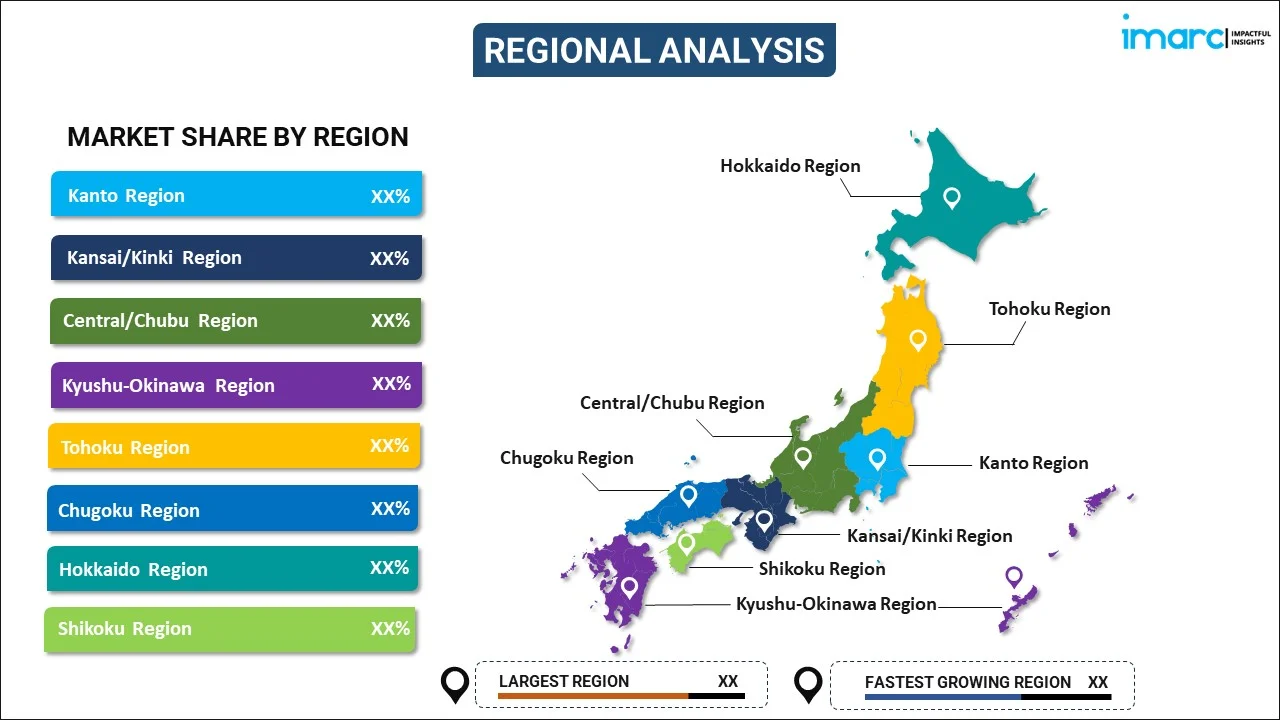
Japan Cement Market Report by Type (Blended, Portland, and Others), End Use (Residential, Commercial, Infrastructure), and Region 2025-2033
Market Overview:
Japan cement market size reached 33.9 Million Tons in 2024. Looking forward, IMARC Group expects the market to reach 61.4 Million Tons by 2033, exhibiting a growth rate (CAGR) of 6.4% during 2025-2033. A significant rise in infrastructure development activities across the country, ongoing technological innovation in eco-friendly products, and an aging population necessitating new healthcare and residential facilities represent some of the key factors driving the market.
|
Report Attribute
|
Key Statistics
|
|---|---|
|
Base Year
|
2024 |
|
Forecast Years
|
2025-2033 |
|
Historical Years
|
2019-2024
|
| Market Size in 2024 | 33.9 Million Tons |
| Market Forecast in 2033 | 61.4 Million Tons |
| Market Growth Rate (2025-2033) | 6.4% |
Cement is an indispensable material in modern construction, particularly in the making of concrete. Composed primarily of materials like limestone, clay, shells, and silica sand, cement undergoes a meticulous process of crushing and heating, resulting in a fine powder. When mixed with water, aggregates such as sand or gravel, and other additives, it forms concrete, which is an essential material in various types of construction projects ranging from buildings to roads and bridges. There are various types of cement, including Portland cement, slag cement, and fly ash cement, each with its unique properties and applications. Portland cement, in particular, is the most commonly used, comprising about 85% of all cement types. It possesses excellent strength and durability, making it a versatile choice for numerous construction requirements. The manufacturing of cement is highly energy-intensive, often requiring temperatures as high as 1450 degrees Celsius. This has led to growing concerns about its environmental impact, including carbon emissions. As a result, the cement industry is actively exploring sustainable alternatives and improvements in manufacturing techniques.
Japan Cement Market Trends:
The Japan cement market is currently experiencing growth, driven by multiple factors. One of the primary drivers is the country's focus on infrastructure development. Japan, being a nation prone to natural disasters such as earthquakes and tsunamis, is heavily investing in resilient and durable structures. This leads to a steady demand for high-quality cement. The government is also channeling resources into urban development projects, transportation infrastructure, and disaster prevention initiatives, all of which extensively use cement. Moreover, ongoing technological innovation represents another major growth-inducing factor. Japanese companies are at the forefront of developing advanced, eco-friendly types of cement that reduce carbon emissions and utilize waste materials. This aligns well with global sustainability goals and also offers a competitive edge in both domestic and international markets. For instance, new formulations of cement are being made from industrial waste or by-products, thus reducing the environmental impact associated with its production. In addition, Japan's aging population is creating a need for new healthcare and residential facilities, resulting in a significant rise in construction activities aimed at catering to this demographic, thereby positively influencing market growth. Furthermore, trade dynamics play a crucial role in stimulating market growth as Japan is a substantial consumer and exporter of cement, especially to the United States and other countries in Asia. Therefore, international trade agreements and strong diplomatic relations are catalyzing the demand for Japanese cement in the global market. Besides this, the increasing policy support from the government in the form of tax incentives for construction and infrastructure projects is further fueling the market growth.
Japan Cement Market Segmentation:
IMARC Group provides an analysis of the key trends in each segment of the market, along with forecasts at the country level for 2025-2033. Our report has categorized the market based on type and end use.
Type Insights:

- Blended
- Portland
- Others
The report has provided a detailed breakup and analysis of the market based on the type. This includes blended, portland, and others.
End Use Insights:
- Residential
- Commercial
- Infrastructure
A detailed breakup and analysis of the market based on the end use have also been provided in the report. This includes residential, commercial, and infrastructure.
Regional Insights:

- Kanto Region
- Kansai/Kinki Region
- Central/ Chubu Region
- Kyushu-Okinawa Region
- Tohoku Region
- Chugoku Region
- Hokkaido Region
- Shikoku Region
The report has also provided a comprehensive analysis of all the major regional markets, which include Kanto Region, Kansai/Kinki Region, Central/ Chubu Region, Kyushu-Okinawa Region, Tohoku Region, Chugoku Region, Hokkaido Region, and Shikoku Region.
Competitive Landscape:
The market research report has also provided a comprehensive analysis of the competitive landscape. Competitive analysis such as market structure, key player positioning, top winning strategies, competitive dashboard, and company evaluation quadrant has been covered in the report. Also, detailed profiles of all major companies have been provided. Some of the key players include:
- ASO Cement Co. Ltd.
- Hitachi Cement Co. Ltd.
- Mitsubishi UBE Cement Corporation
- Nippon Steel Cement Co. Ltd.
- Sumitomo Osaka Cement Co. Ltd.
- Taiheiyo Cement Corporation
(Please note that this is only a partial list of the key players, and the complete list is provided in the report.)
Japan Cement Market Report Coverage:
| Report Features | Details |
|---|---|
| Base Year of the Analysis | 2024 |
| Historical Period | 2019-2024 |
| Forecast Period | 2025-2033 |
| Units | Million Tons |
| Scope of the Report | Exploration of Historical Trends and Market Outlook, Industry Catalysts and Challenges, Segment-Wise Historical and Future Market Assessment:
|
| Types Covered | Blended, Portland, Others |
| End Uses Covered | Residential, Commercial, Infrastructure |
| Regions Covered | Kanto Region, Kansai/Kinki Region, Central/ Chubu Region, Kyushu-Okinawa Region, Tohoku Region, Chugoku Region, Hokkaido Region, Shikoku Region |
| Companies Covered | ASO Cement Co. Ltd., Hitachi Cement Co. Ltd., Mitsubishi UBE Cement Corporation, Nippon Steel Cement Co. Ltd., Sumitomo Osaka Cement Co. Ltd., Taiheiyo Cement Corporation, etc. |
| Customization Scope | 10% Free Customization |
| Post-Sale Analyst Support | 10-12 Weeks |
| Delivery Format | PDF and Excel through Email (We can also provide the editable version of the report in PPT/Word format on special request) |
Key Questions Answered in This Report:
- How has the Japan cement market performed so far and how will it perform in the coming years?
- What has been the impact of COVID-19 on the Japan cement market?
- What is the breakup of the Japan cement market on the basis of type?
- What is the breakup of the Japan cement market on the basis of end use?
- What are the various stages in the value chain of the Japan cement market?
- What are the key driving factors and challenges in the Japan cement?
- What is the structure of the Japan cement market and who are the key players?
- What is the degree of competition in the Japan cement market?
Key Benefits for Stakeholders:
- IMARC’s industry report offers a comprehensive quantitative analysis of various market segments, historical and current market trends, market forecasts, and dynamics of the Japan cement market from 2019-2033.
- The research report provides the latest information on the market drivers, challenges, and opportunities in the Japan cement market.
- Porter's five forces analysis assist stakeholders in assessing the impact of new entrants, competitive rivalry, supplier power, buyer power, and the threat of substitution. It helps stakeholders to analyze the level of competition within the Japan cement industry and its attractiveness.
- Competitive landscape allows stakeholders to understand their competitive environment and provides an insight into the current positions of key players in the market.
Need more help?
- Speak to our experienced analysts for insights on the current market scenarios.
- Include additional segments and countries to customize the report as per your requirement.
- Gain an unparalleled competitive advantage in your domain by understanding how to utilize the report and positively impacting your operations and revenue.
- For further assistance, please connect with our analysts.
 Inquire Before Buying
Inquire Before Buying
 Speak to an Analyst
Speak to an Analyst
 Request Brochure
Request Brochure
 Request Customization
Request Customization




.webp)




.webp)












